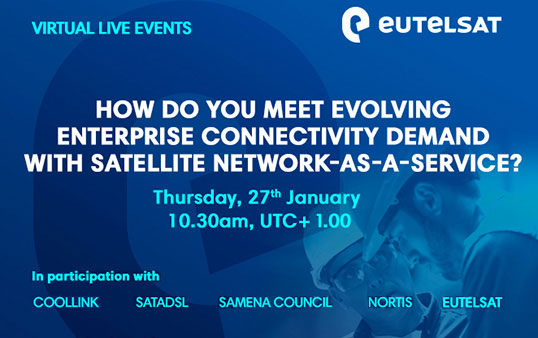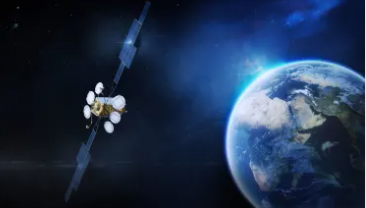Hosted by industry journalist Chris Forrester, Eutelsat’s Ghassan Murat, MD of Eutelsat MENA, and representatives from Media Digital Space, Rotana, and Facebook discuss the future of home-entertainment and viewing in this live webinar.
The MENA region covers a vast array of countries across the Middle East and North Africa. The 578 million people that call the region home represent a rapidly expanding market that each spent approximately 348.1 minutes per day in front of the television in 2018. IDATE DigiWorld is forecasting a 35.7% growth in the MENA region’s television and video market between 2018 and 2023, taking the total market value from 10.9 billion to 14.8 billion EUR. Needless to say, the MENA region is an opportunity that broadcasters cannot afford to ignore.
Eutelsat recently hosted a roundtable discussion webinar with four experts on broadcasting throughout the MENA region. Hosted by industry tech-journalist Chris Forrester, the webinar answered questions on topics such as influences on content consumption, how to grow market share, how strong advertising support is in the region and the future of pay-TV. Representatives from Rotana Media Group, Facebook, Digital Media Space and Eutelsat participated in a live discussion to answer and discuss questions and topics from the audience and other industry professionals.
If you would like to hear what they had to say - stay tuned. This blog will highlight five key takeaways from the webinar.
TV consumption is becoming more social and mobile
“TV is a pivotal part of the conversation on social channels. It would be a wise decision for broadcasters to leverage and explore these platforms to increase their reach to younger audiences. The user base is moving towards other screens besides just traditional TV” - Fares Akkad, Director, Media Partnership for Growth Markets, Facebook.
Over 70% of the MENA region is under 30 and very socially active. Channels such as Instagram, WhatsApp and TikTok have indicated that the region’s viewers desire more than a single stream of communication and prefer to be active viewers rather than passive ones.
“If you look at technology like smart-tv, back chain and mobile, we are almost already there. I think it’s time to start opening a window into the big screen to have an engagement with the viewer. This will make a different experience that will maintain TV viewers.”, says Hassan Chanine, CEO of Digital Media Space.
The convergence between content consumption and communication was highlighted, as people want to interact with their broadcaster and voice their views, share content with others and have an impact on what content is offered into the future. The speakers also mentioned the need for broadcasters to adjust their content to match smaller screens and the user state of mind when consuming content on phones and tablets. The attention span of viewers today is shrinking, and broadcasters need to create short, ‘snackable’ content to generate engagement.
Viewing is up, but advertising has slowed - for now
“[TV] viewing is up 20 - 40%. Unfortunately, that increased viewing has not led to more advertising. Due to COVID-19, advertisers have halted their campaigns because either their products are unavailable or people can’t consume them. We are seeing some positive shoots of growth in September and October.” - Michael Cairns, COO, Rotana Media Group
The effect of the COVID-19 pandemic has had a toll on advertising from Europe to the MENA region. While TV viewing has dramatically increased, advertisers have shied away from investing more in TV marketing.
“Perhaps it’s time to look outside of traditional advertising packages to other ways of advertising - online, digital, and social - and offering smaller packages. This will also open up for the future of diversifying advertisement. Broadcasters will have to work heavily on this component to prepare for the future.” said Chanine.
“We need to move away from a traditional MENA-wide 30-second slot. The future will be more targeted, whether that is country, region or network-specific. Broadcasters will need to look at technology where they can target and engage more specific markets to gain more advertisers and cater for smaller budgets.” added Cairns.
Satellite viewing is still the first choice across the region
“There is (approximately) a 98% penetration rate in the MENA region for satellite TV. The main two reasons in favour of satellite TV are better quality and more choice.” - Ghassan Murat, Managing Director, Eutelsat MENA.
The demand for satellite TV continues to grow throughout MENA due to the quality and amount of choice. While larger cities such as Dubai are adopting broadband on-demand viewing services, the vast majority outside of the cities rely on satellite entertainment.
Murat went on to say that it is upon the values of quality and choice that Eutelsat will be developing for the MENA region. “We are working on making SuperHD a good alternative to 4k, until the 4k ecosystem is ready.” SuperHD offers higher quality images at 15 to 16Mbps, rather than the standard 5 to 6 Mbps HD channel, and is compatible for most satellite-enabled TV sets in the region. He noted that there has been widespread positive feedback, particularly for sports events.
“Also, to improve the user experience, we’ve just launched the Sat.tv box on 7/8° West, which will be the first electronic programme guide for free-to-air channels in MENA, providing more convenience and awareness of choice.” added Ghassan. “We aim to standardise this throughout the region.”
5G will take time to develop and implement
“5G will take time. Having an island of 5G in Dubai, Doha or Riyadh doesn’t really make sense [for us] at the moment. Are we really getting benefit out of it? I think this will take time. There are a lot of other platforms that we can capitalise on now” - Hassan Chanine, CEO of Digital Media Space.
Telecommunications companies have been promoting 5G as an alternative channel for broadcasters to use. However, the technology doesn’t have the same reach or reliability as other channels like satellite.
“It’s a very expensive technology for the time being. Before consumers start to accept 5G widely, there needs to be a pricing adjustment. I believe 5G will develop as a viable channel, but it will take time. For now, people seem happy with their existing speeds of downloads. From a broadcaster point of view, it comes down to another delivery mechanism.” said Rotana’s Cairns.
Eutelsat's Murat added that regardless of how 5G develops, it will still require satellite to gain widespread reach, and would instead likely affect the OTT offerings throughout the region.
Broadcasters expect satellite to remain the best way to reach homes 20 years from now
“As a broadcasting technology to reach a mass market in an economical way, satellite provides that possibility and will continue to do so. The build out of other networks to address 100% of the population won’t happen fast enough.” - Michael Cairns, COO, Rotana Media Group
“Don’t just think about the cities, consider the countries, and the potential for people to pay for content. Free-to-air and satellite will survive - especially - in the MENA region, for a long time.” - Hassan Chanine, CEO of Digital Media Space
There is an unshakeable confidence in broadcasters that satellite will continue to be a reliable and useful tool to broadcast throughout the MENA region. The reach, reliability and economic viability it presents is still an attractive aspect of the service.
“When we listen to our users, we can see that quality is a big advantage for satellite. We will continue to work to create more incentives for using higher channel bandwidth, and to improve the end-user experience,” said Ghassan Murat from Eutelsat.
Satellite was also highlighted as a two-way communication proposition. Satellite broadband connectivity solutions are being developed as we speak for the MENA region, and companies such as Amazon and SpaceX continue to invest in satellite. “We will not sit and wait. We are actively servicing those needs - ubiquitous, widespread broadband connectivity via satellite will come to the region.”, concluded Ghassan.
Watch the webinar
These five key takeaways from the webinar are only a taste of the informative discussion. If you would like to watch the full webinar, click here to begin viewing.
If you want to find out more about what Eutelsat has in store for broadcasters and the MENA region, visit our website for more updates.



